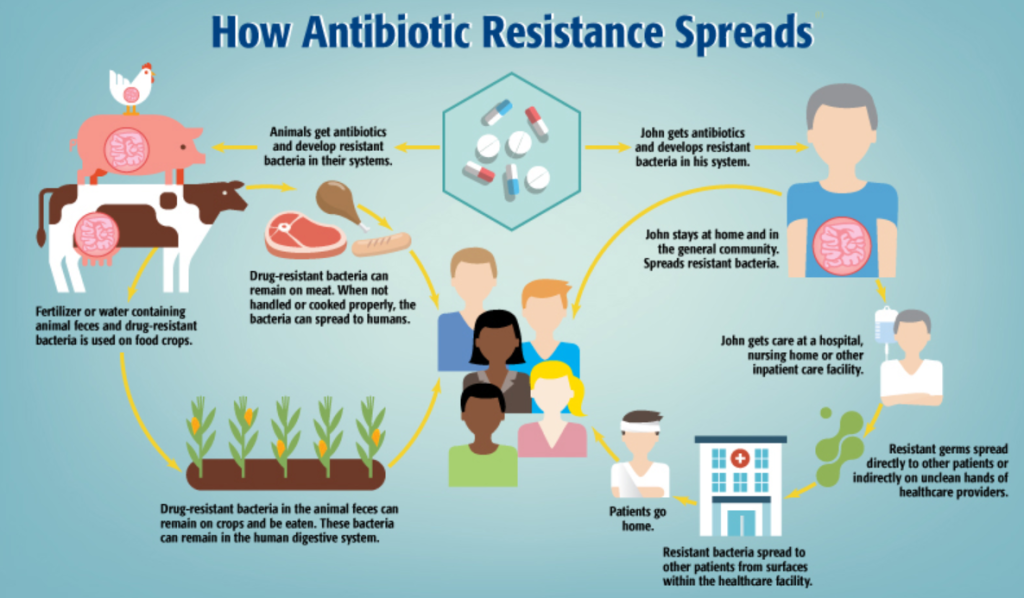CONTENTS
- Are antibiotics Over-Prescribed in India?
- Startups in the Agriculture Sector are Pioneering Innovations
Are Antibiotics Over-Prescribed in India?
Context:
The National Centre for Disease Control (NCDC) recently conducted a study which revealed that more than half of the nearly 10,000 hospital patients surveyed were administered antibiotics as a preventive measure rather than for treating infections. The survey covered patients treated over one to five days in 20 tertiary care institutes across 15 States and two Union Territories between November 2021 and April 2022. The findings indicated that 55% of the surveyed patients received antibiotics as prophylaxis, while only 45% were prescribed antibiotics for actual infection treatment.
Relevance:
- GS2- Health
- GS3- Biotechnology
Mains Question:
Highlight the factors that have led to a rise of Anti-Microbial Resistance in India? Provide a detailed overview of the government’s strategy in this regard and suggest what more can be done to effectively deal with the menace of Anti-Microbial Resistance (AMR). (15 Marks, 250 Words).
About Anti-Microbial Resistance (AMR):
- AMR, or antimicrobial resistance, is defined as the resistance of microorganisms to an antimicrobial agent to which they were initially sensitive.
- The current significant concern regarding AMR is that various types of bacteria, particularly in the Indian context—such as E. coli, Klebsiella, Acinetobacter, Staphylococcus aureus, and enterococcus—have developed resistance even to some of the latest generation antibiotics.

Causes of rising AMR:
The inappropriate use of antibiotics:
- The inappropriate use of antibiotics in non-bacterial infections, driven by both prescribing practices and the availability of over-the-counter antibiotics.
- The pharmaceutical industry’s encouragement of prescribing practices through incentivization adds to the challenges associated with addressing AMR.
- The inappropriate utilization of antibiotics and other substances employed for treating or preventing infections in the human, animal, and agricultural domains results in the emergence of drug-resistant microorganisms.
Lack of sufficient laboratory facilities:
- The lack of sufficient laboratory facilities to promptly guide clinicians in selecting appropriate antibiotics for bacterial infections based on cultures, leading to a scenario where clinicians often make decisions without adequate information.
- Limited time for patient history and examination, coupled with a lack of access to rapid diagnostics and a comprehensive network of laboratories, leads to a reliance on antibiotics, which are cheaper and less time-consuming compared to extensive investigations.
- Prescription practices are identified as a significant obstacle, emphasizing the crucial need to connect laboratories with clinical setups and facilitate the rapid transmission of infection-related data between labs and clinicians.
Deficiency in Adequate Training:
The deficiency in adequate training related to antibiotic selection, escalation, and de-escalation.
Insufficient Monitoring:
- Insufficient monitoring of AMR and a lack of control over antibiotic prescription and dispensing practices by health systems, despite repeated warnings.
- AMR is intricately linked to governance, infrastructure, sanitation, poverty, and access to clean drinking water. While rationalizing antibiotics is important, it alone may not significantly alter resistance rates in a country with high AMR.
- Factors like hospital sanitation, access to personal hygiene, and infection control also play an important role in AMR.
- Inadequate sanitation within communities and insufficient infection prevention measures in healthcare facilities contribute to the dissemination of these highly resistant strains.
Way Forward:
- Antimicrobial resistance (AMR) is a multifaceted socio-economic and political challenge, transcending the realm of a purely scientific issue that can be addressed solely by doctors and researchers.
- Given the recent report from the National Centre for Disease Control (NCDC), there is a question about the need for standardization to ensure consistency in prescribing antibiotics.
- The differentiation between bacterial and non-bacterial infections or non-infective causes heavily relies on clinical judgment, with laboratory and radiological investigations providing supportive information. Until more precise and readily available diagnostic methods are developed, the initial diagnosis of bacterial infections will continue to depend on clinical judgment.
- Despite existing guidelines from institutions like the NCDC and the Indian Council for Medical Research (ICMR), the problem lies in the implementation of these guidelines.
- There is a need of investigating the root causes of over-prescription, pointing out the overcrowded nature of both government and private hospital outpatient units. The challenge also lies in accurately diagnosing whether a patient has a bacterial infection.
- After the experience of COVID-19 and the acknowledgment of humanity’s vulnerability to the ongoing threat of outbreaks due to climate change, zoonotic spillovers, and resistance emerging from agriculture and poultry, the judicious use of antibiotics globally is of paramount importance.
- There is a need to emphasize on the significance of basic measures like handwashing and mask-wearing in countering major threats, advocating a similar approach for tackling AMR.
- There is a need for strong coordination between the Center and States as tackling AMR requires collaboration with all stakeholders, including patients.
Government Measures:
- The National Policy for Containment of Antimicrobial Resistance was introduced in 2011, along with a ban on over-the-counter antibiotic use (H1 rule), although implementation was lacking.
- Subsequently, a modified H1 rule banning only second- and third-line antibiotics was introduced in 2013.
AMR National Action Plan (NAP):
- In April 2017, the Union Ministry of Health and Family Welfare unveiled India’s National Action Plan (NAP) for Antimicrobial Resistance (AMR).
- The objectives of the NAP encompass elevating awareness, reinforcing surveillance, fostering research, and enhancing infection prevention and control measures.
Delhi Declaration on AMR:
- The Delhi Declaration on Antimicrobial Resistance (AMR) signifies an inter-ministerial consensus inked by the relevant ministries’ ministers in India.
- The declaration aims to combat AMR proactively by engaging research institutions, civil society, industry, small- and medium-sized enterprises, and fostering public-private partnerships.
Antibiotic Stewardship Program (AMSP):
- The Indian Council of Medical Research (ICMR) has initiated the Antibiotic Stewardship Program (AMSP) on a pilot project basis in 20 tertiary care hospitals across India.
- The program strives to regulate the inappropriate use and overuse of antibiotics in hospital wards and intensive care units (ICUs).
Ban on inappropriate fixed dose combinations (FDCs):
Based on recommendations from the ICMR, the Drug Controller General of India (DCGI) has enforced a ban on 40 fixed dose combinations (FDCs) found to be unsuitable.
Ban on Colistin in animal feed:
In collaboration with the Indian Council of Agriculture Research, Department of Animal Husbandry, Dairy and Fisheries, and the DCGI, the ICMR has implemented a ban on the use of Colistin as a growth promoter in poultry feed.
One Health approach:
The government is actively promoting a One Health approach, encouraging interdisciplinary collaboration at the human-animal-environmental interface. Key focus areas include addressing zoonotic diseases, ensuring food safety, and mitigating antibiotic resistance.
Integrated One Health Surveillance Network for AMR:
- The ICMR has undertaken a project for an “Integrated One Health Surveillance Network for Antimicrobial Resistance” in collaboration with the Indian Council of Agriculture Research.
- The initiative aims to assess the readiness of Indian Veterinary laboratories to participate in a comprehensive AMR surveillance network.
Conclusion:
Hence, India has implemented various measures to address the growing concern of AMR, better law enforcement, restricting access to reserve antibiotics to reduce resistance, improving public health systems, delivery, sanitation, and planned expenditure, with accountable public health systems contributing to lower AMR in states with robust public health infrastructure needs to be encouraged.
Startups in the Agriculture Sector are Pioneering Innovations
Context:
Agriculture, a cornerstone of India’s economy, contributes nearly 17% to the country’s GDP, surpassing the global average of 4.4%. In the global endeavor to sustainably feed a growing population, technological advancements and innovation in agriculture have become more crucial than ever. In recent times, the Indian agricultural landscape has undergone a transformative shift driven by the emerging Agri-Tech startup ecosystem.
Relevance:
GS-3
- E-Technology in the Aid of Farmers
- Agricultural Marketing
- Growth & Development
Mains Question:
Positioned as leaders in innovation, the agri-tech startups are not only tackling persistent structural challenges but are also establishing the groundwork for a more sustainable and prosperous future. Discuss. (15 Marks, 250 Words).
Role of the Agri-Tech Startup Ecosystem:
- Positioned at the forefront of innovation, these startups are not only tackling long-standing structural challenges but are also laying the groundwork for a more sustainable and prosperous future.
- They are achieving this by enhancing farm productivity and ecological sustainability across the entire agricultural value chain.
- Favorable government policies, increased technology access, and a rising demand for high-quality produce have spurred the growth of Agri-Tech startups across the country.
- In an unprecedented era of technological ubiquity in India, dynamic entrepreneurs are leveraging cutting-edge technologies such as Artificial Intelligence (AI), Internet of Things (IoT), Machine Learning, and Data Analytics to address agricultural challenges.
- Presently, over 2000 Agri-Tech startups are actively operating in various domains, including organic agriculture, food processing, horticulture, animal husbandry and dairying, fisheries, and a diverse range of agriculture-related activities.
- They aim to provide innovative solutions to India’s agriculture sector. According to praxis analysis, the agri-tech sector has attracted substantial investments, amounting to approximately USD 958 million in 2022, growing at a Compound Annual Growth Rate (CAGR) of about 51% from 2017 to 2022.


Empowering Farmers:
- Agri-tech startups empower farmers to make data-driven decisions, adopt modern practices, and access real-time information through their innovative digital solutions.
- These solutions offer farmers higher profit margins, assistance in crop grading and packaging, product traceability, market exposure, access to quality inputs, and scientific guidance.
- They have led to the development of high-yielding seed varieties and the adoption of technology-driven solutions like tractors, drones, and robots, thereby enhancing operational efficiency.
Environmental Sustainability:
- Agri-tech contributes to environmental conservation and climate change mitigation through ecologically sustainable practices such as organic and precision farming, agroforestry, crop rotation, and water management solutions.
- The convergence of digital platforms, mechanization, and biotechnology has significantly increased farm output, improved crop quality, and reduced wastage.
Democratization of Information:
- Agri-tech startups have effectively addressed critical challenges in the Indian agricultural industry, including real-time weather forecasting, disaster mitigation, and resilience.
- These startups bridge the information gap for farmers through mobile applications and digital platforms, providing access to weather forecasts, market prices, and expert advice.
- This democratization of information empowers farmers to make informed decisions, negotiate better prices, and enhance overall farm management.
Addressing Structural Supply-Chain and Logistics Challenges:
- Addressing structural supply-chain and logistics challenges has been another success for Agri-tech startups.
- Inefficiencies in the supply chain, including inadequate forward and backward linkages, labor sourcing inefficiencies, and the lack of market access, have historically impacted farmers’ profits.
- Agri-tech startups are introducing innovative solutions to streamline the agricultural supply chain, employing technologies like blockchain for farm-to-fork traceability and data-driven logistics optimization.
- These initiatives ensure that produce reaches the market efficiently, reducing wastage and ensuring fair compensation for farmers.
Access to Financing:
- Access to fair finance has been a historical impediment for Indian farmers, hindering productivity and technological advancements.
- Today, Agritech startups offer tailored solutions, providing timely credit, crop insurance, and financial products.
- Government initiatives, such as e-NAM, Kisan Suvidha app, and Rashtriya Krishi Vikas Yojana, complement the efforts of Agri-tech startups, supporting the agricultural sector.
- The Software Technology Parks of India (STPI), under MeitY, contributes to the growth of Agritech startups by offering mentoring and funding through three Centers of Excellence (CoEs).
Conclusion:
The agri-tech ecosystem not only addresses immediate challenges but also promotes sustainable practices, resource efficiency, and rural development. The digitalization of agriculture attracts tech-savvy individuals, revitalizing the sector for a more vibrant and dynamic landscape and ensuring a brighter future for India.





